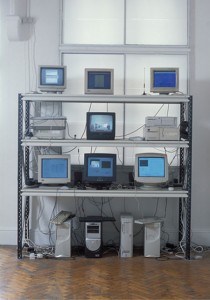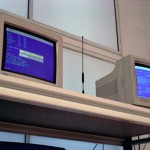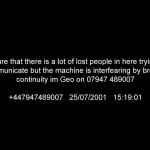 A screen in amongst a rack of computers installed in the gallery would invite visitors to send a cellular phone text message, which would connect them to the Digital Warfare Network. If they complied, the installation would immediately send a text message to the visitor, telling them that they had become part of the Digital Warfare Network.
A screen in amongst a rack of computers installed in the gallery would invite visitors to send a cellular phone text message, which would connect them to the Digital Warfare Network. If they complied, the installation would immediately send a text message to the visitor, telling them that they had become part of the Digital Warfare Network.
All the information that the system could get from the visitor’s message was automatically stored inside a database: message, phone number, date, time, etc. Every ten minutes, the system would select a message and a phone number from its database and send it to somebody connected to its system. The effect of this was that over the course of the time the project was exhibited, over 2,000 people were connected to the installation’s system via their cellular phones and intermittently received messages from each other.
The text message system allowed users to connect with the network remotely, as well as locating them within a community of people who had shared the common experience of having physically visited the installation. The overriding aim of Project Phase Two was to provide the viewer with the sense of a system whose location extended over both physical and virtual spaces, far beyond the gallery space itself. The autonomy of this system, as something that had been initiated by the artist but which was now evolving in response to the visitors’ inputs became an important focus for how people responded to the messages they received.
The installation’s system was fundamentally a “private”, parasitical system: it used Vodafone’s cellular network to connect the people in its database together. The nature of this parasitical relationship between artwork and network was exposed to good effect when a Vodafone salesman attempted to sell cheaper text messages to the installation’s SIMM card and inadvertently inserted Vodaphone into the Digital Warfare Network. This incident demonstrated how the system’s autonomy afforded it a certain agenda. As a parasite, it was able to critique the politics of its host system, and develop a series of aesthetic values that were clearly distinct from object-based art.
 |
 |
 |
 |